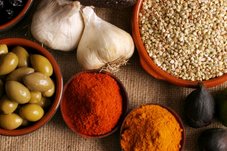Cooking at home is different in many respects to cooking professionally. However, professional principles can be adapted and employed by home cooks. Knowing the goals and how to reach them will help to reduce time and increase efficiency of food preparation. Mise en place means to put in place or to have everything in its place. It begins with the recipe. The goal is to do as much work in advance as possible without loosing the quality of the food.
Even on the simplest level preparation is necessary. Most seasoned cooks do it without giving much thought to what we are actually doing. Novices learn this over time, practice and some hard knocks. You have to assemble your tools, ready your work area, assemble your ingredients, wash, trim, cut, prepare, and measure your raw materials, and prepare your equipment (i.e. preheat the oven, line baking sheets, etc.).
Ok, so here is the challenge. Some of the work must be done ahead but most foods, not all mind you, are at their best quality immediately after they are prepared. Remember the goal: to do as much work in advance as possible without loss of quality. Keep in mind that time is relative. We could be speaking of minutes, hours or even days depending upon the preparation.
In professional food service we look at a variety of preparation styles but the one most home cooks use is what is termed as Set Meal Service. In other words, all our food is cooked as needed in small batches, and, hopefully, everyone eats at the same time. No one I know who cooks at home cooks to order as people are ready to eat. This preparation style, known professionally as Extended Meal Service or A La Carte, requires an even more extensive preparation style. When preparing stir fries or quick sautés at home we do, however, utilize a modified version of this preparation style.
Now we come to the solution. First plan preparation carefully breaking each menu item down into its stages of production. With time and experience this comes quite naturally. Figure out how long it takes to prepare each stage of each recipe, beginning with the preparations that take the longest. Determine what may be done in advance. First assemble and prepare the ingredients then move on to those stages of preparation that may be done in advance without loss of quality. Final cooking should be a close to service time as possible for maximum freshness. Some dishes may be completed well in advance and merely heated or finished whereas some need to be cooked just prior to service.
Once you begin to grasp this concept, as any experienced cook knows, you may multitask several preparations at a time increasing your efficiency and reducing the amount of time you have to spend on meal preparation. Just keep the goal in mind: to do as much work in advance as possible without loss of quality.
